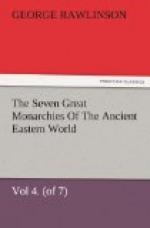Of all the productions of the Babylonians none obtained such, high repute in ancient times as their textile fabrics. Their carpets especially were of great celebrity, and were largely exported to foreign countries. They were dyed of various colors, and represented objects similar to those found on the gems, as griffins and such like monsters. Their position in the ancient world may be compared to that which is now borne by the fabrics of Turkey and Persia, which are deservedly preferred to those of all other countries.
Next to their carpets, the highest, character was borne by their muslins. Formed of the finest cotton, and dyed of the most brilliant colors, they seemed to the Oriental the very best possible material for dress. The Persian kings preferred them for their own wear; and they had an early fame in foreign countries at a considerable distance from Babylonia. It is probable that they were sometimes embroidered with delicate patterns, such as those which may be seen on the garments of the early Babylonian kings.
Besides woollen and cotton fabrics, the Babylonians also manufactured a good deal of linen cloth, the principal seat of the manufacture being Borsippa. This material was produced, it is probable, chiefly for home consumption, long linen robes being generally worn by the people.
From the arts of the Babylonians we may now pass to their science—an obscure subject, but one which possesses more than common interest. If the classical writers were correct in their belief that Chaldaea was the birthplace of Astronomy, and that their own astronomical science was derived mainly from this quarter, it must be well worth inquiry what the amount of knowledge was which the Babylonians attained on the subject, and what were the means whereby they made their discoveries.
On the broad flat plains of Chaldsea, where the entire celestial hemisphere is continually visible to every eye, and the clear transparent atmosphere shows night after night the heavens gemmed with countless stars, each shining with a brilliancy unknown in our moist northern climes, the attention of man was naturally turned earlier than elsewhere to these luminous bodies, and attempts were made to grasp, and reduce to scientific form, the array of facts which nature presented to the eye in a confused and tangled mass. It required no very long course of observation to acquaint men with a truth, which at first sight none would have suspected—namely, that the luminous points whereof the sky was full were of two kinds, some always maintaining the same position relatively to one another, while others were constantly changing their places, and as it were wandering about the sky. It is certain that the Babylonians at a very early date distinguished from the fixed stars those remarkable five, which, from their wandering propensities, the Greeks called the “planets,” and which are the only erratic stars that the naked eye, or




